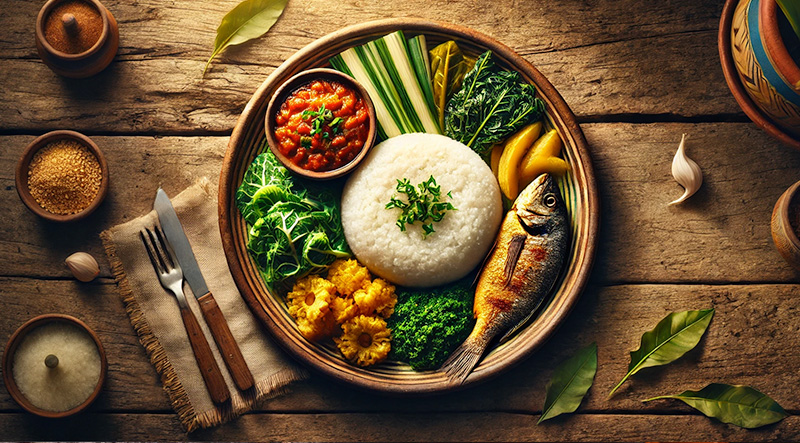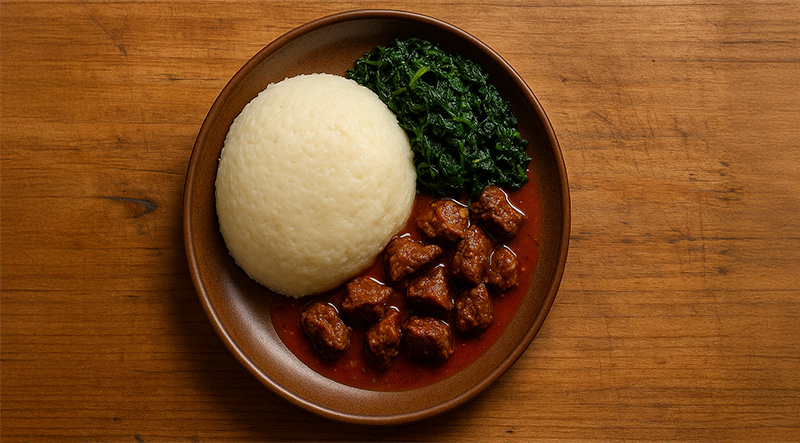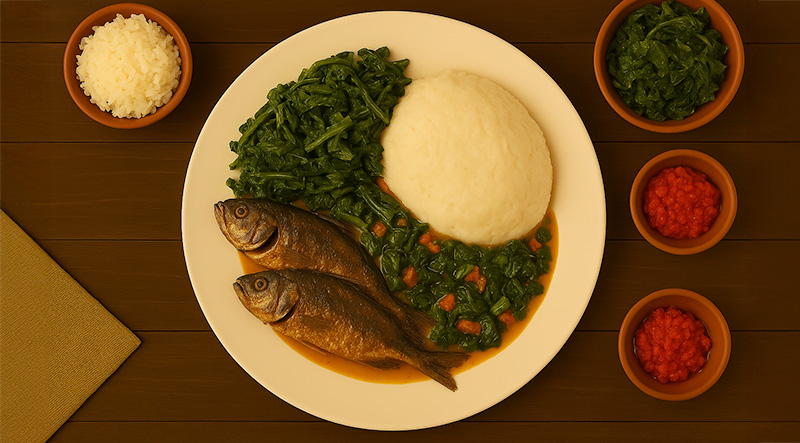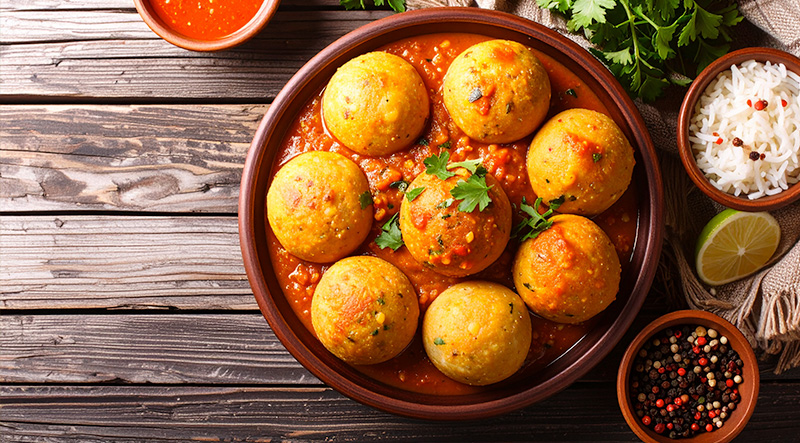The main ingredient in every Malawian meal is nsima, which is tender, warm, and incredibly satisfying. Made from finely ground maize flour and water, this simple but necessary dish turns into a smooth, dough-like mound that's ideal for scooping up flavorful relishes like beans, greens, or spicy meats. Nsima is more than just food; it's a daily ritual that unites families around the table throughout Malawi and serves as a symbol of sustenance, solidarity, and tradition. It's the ultimate comfort food—simple and soulful. Read More...
The History of Malawi’s National Dish – Nsima:
In Malawi, food is far more than sustenance—it is deeply woven into the nation’s culture, family life, and identity. At the center of it all is nsima, a dish so foundational and beloved that it has become synonymous with the Malawian way of life. Made from ground maize flour and water, nsima is a simple yet iconic staple that has nourished generations. To understand nsima is to understand the heartbeat of Malawi itself.
Origins in Agriculture and Ancestry:
The roots of nsima trace back to centuries ago, when early communities in southeastern Africa cultivated grains such as millet and sorghum. These grains were the original ingredients for similar porridge-like staples that predate maize, which was only introduced to Africa from the Americas in the 16th and 17th centuries through Portuguese trade.
Maize eventually became Malawi’s most important crop, thanks to its high yields and adaptability. By the 19th century, maize had replaced traditional grains in most Malawian households, giving rise to the version of nsima most widely recognized today—a thick porridge made by slowly mixing maize flour (known locally as ufa) into boiling water until it becomes firm enough to mold by hand.
A Daily Dish With Deep Cultural Roots:
Nsima is not just a dish; it is the foundation of nearly every meal in Malawi. Eaten two or even three times a day, nsima is served with an assortment of side dishes known as relishes—these include vegetables, beans, fish like chambo or usipa, or meat stews when available. Though the relishes may vary, the presence of nsima is constant and deeply cherished.
The preparation and consumption of nsima are steeped in tradition. It is usually cooked over an open fire in a clay pot, stirred with a wooden paddle called a mthiko, and served family-style. Eating with the hands is customary, and each bite is shaped into a ball and used to scoop up the flavorful accompaniments—fostering a sense of unity and shared experience.
Symbol of Identity and Resilience:
In Malawian culture, nsima represents much more than a meal—it symbolizes resilience, community, and sustenance. A common phrase in Malawi is “chakudya ndi nsima,” meaning “food is nsima.” This speaks volumes about the central role it plays in people’s lives. During periods of food insecurity, when maize harvests falter due to drought or flooding, the absence of nsima on the table is felt as a national hardship.
Over time, nsima has become a political and economic touchstone as well. Government policies have long focused on maize farming and food security, understanding that the ability to afford and access nsima is a direct reflection of the country’s well-being.
Nsima in the Modern Day:
Despite modernization and globalization, nsima has held its place as Malawi’s national dish and cultural cornerstone. While some urban Malawians are exploring new ingredients or cooking methods, nsima remains a non-negotiable part of everyday life. Its preparation is even taught in schools as a basic life skill, and it remains central in family gatherings, ceremonies, and holidays.
In the Malawian diaspora, nsima continues to connect people to their roots, appearing on dinner tables from Johannesburg to London to Chicago. It has also begun to attract interest among international food lovers eager to explore authentic African cuisines.
Conclusion: More Than a Meal:
Nsima’s enduring legacy lies in its simplicity, versatility, and deep emotional resonance. It tells the story of Malawi’s agricultural evolution, cultural unity, and culinary resilience. Whether served with a rich tomato-based stew or humble sautéed greens, nsima remains a dish of comfort, community, and cultural pride—earning its rightful place as the national dish of Malawi.
The History of Malawi’s National Dish: Nsima
In Malawi, food is far more than sustenance—it is deeply woven into the nation’s culture, family life, and identity. At the center of it all is nsima, a dish so foundational and beloved that it has become synonymous with the Malawian way of life. Made from ground maize flour and water, nsima is a simple yet iconic staple that has nourished generations. To understand nsima is to understand the heartbeat of Malawi itself.
Origins in Agriculture and Ancestry:
The roots of nsima trace back to centuries ago, when early communities in southeastern Africa cultivated grains such as millet and sorghum. These grains were the original ingredients for similar porridge-like staples that predate maize, which was only introduced to Africa from the Americas in the 16th and 17th centuries through Portuguese trade.
Maize eventually became Malawi’s most important crop, thanks to its high yields and adaptability. By the 19th century, maize had replaced traditional grains in most Malawian households, giving rise to the version of nsima most widely recognized today—a thick porridge made by slowly mixing maize flour (known locally as ufa) into boiling water until it becomes firm enough to mold by hand.
A Daily Dish With Deep Cultural Roots:
Nsima is not just a dish; it is the foundation of nearly every meal in Malawi. Eaten two or even three times a day, nsima is served with an assortment of side dishes known as relishes—these include vegetables, beans, fish like chambo or usipa, or meat stews when available. Though the relishes may vary, the presence of nsima is constant and deeply cherished.
The preparation and consumption of nsima are steeped in tradition. It is usually cooked over an open fire in a clay pot, stirred with a wooden paddle called a mthiko, and served family-style. Eating with the hands is customary, and each bite is shaped into a ball and used to scoop up the flavorful accompaniments—fostering a sense of unity and shared experience.
Symbol of Identity and Resilience:
In Malawian culture, nsima represents much more than a meal—it symbolizes resilience, community, and sustenance. A common phrase in Malawi is “chakudya ndi nsima,” meaning “food is nsima.” This speaks volumes about the central role it plays in people’s lives. During periods of food insecurity, when maize harvests falter due to drought or flooding, the absence of nsima on the table is felt as a national hardship.
Over time, nsima has become a political and economic touchstone as well. Government policies have long focused on maize farming and food security, understanding that the ability to afford and access nsima is a direct reflection of the country’s well-being.
Nsima in the Modern Day:
Despite modernization and globalization, nsima has held its place as Malawi’s national dish and cultural cornerstone. While some urban Malawians are exploring new ingredients or cooking methods, nsima remains a non-negotiable part of everyday life. Its preparation is even taught in schools as a basic life skill, and it remains central in family gatherings, ceremonies, and holidays.
In the Malawian diaspora, nsima continues to connect people to their roots, appearing on dinner tables from Johannesburg to London to Chicago. It has also begun to attract interest among international food lovers eager to explore authentic African cuisines.
Conclusion: More Than a Meal:
Nsima’s enduring legacy lies in its simplicity, versatility, and deep emotional resonance. It tells the story of Malawi’s agricultural evolution, cultural unity, and culinary resilience. Whether served with a rich tomato-based stew or humble sautéed greens, nsima remains a dish of comfort, community, and cultural pride—earning its rightful place as the national dish of Malawi.
Heat the Water:
Make a Thin Porridge (Mphodza):

Add Remaining Flour:


Serve:

Tips:
Nsima’s magic lies in its simplicity—it’s a blank canvas for bold, flavorful sides and a daily dish that brings Malawians together across every table and tradition.
The total preparation and cooking time for nsima is approximately 25 to 30 minutes. This includes about 5 minutes of preparation time to measure and mix the maize flour slurry, and 20 to 25 minutes of cooking, during which the porridge is boiled, thickened with additional flour, and stirred vigorously until it reaches the desired firm consistency. The final steaming step ensures it's fully cooked and ready to serve hot with your favorite side dishes.
A single serving of nsima, based on the provided recipe (assuming the recipe yields about 4 servings), contains approximately 150–180 calories. This estimate accounts for the use of ½ cup of maize flour per serving, which is the main source of calories. Nsima is low in fat and sugar, making it a wholesome and energy-rich staple. If optional ingredients like butter or milk are added, the calorie count can increase by 30–60 calories per serving. When paired with protein-rich or saucy side dishes, the overall meal becomes more calorically substantial.







